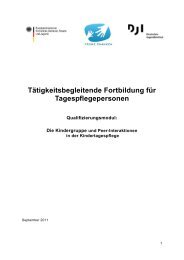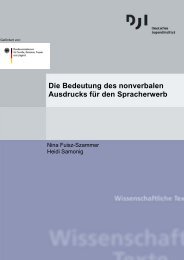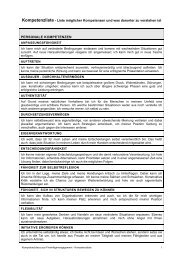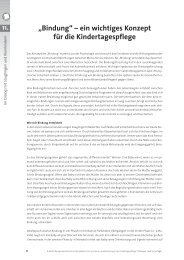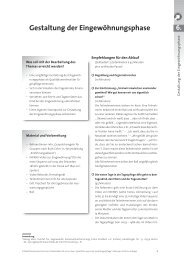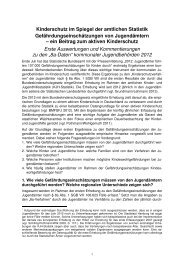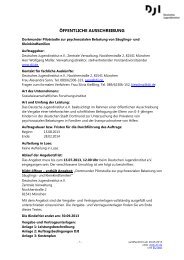Assessing the effects of informal learning on occupational compe ...
Assessing the effects of informal learning on occupational compe ...
Assessing the effects of informal learning on occupational compe ...
You also want an ePaper? Increase the reach of your titles
YUMPU automatically turns print PDFs into web optimized ePapers that Google loves.
and <str<strong>on</strong>g>informal</str<strong>on</strong>g> acquisiti<strong>on</strong> <str<strong>on</strong>g>of</str<strong>on</strong>g> <strong>compe</strong>tences and <str<strong>on</strong>g>the</str<strong>on</strong>g>reby decisively enhance<br />
equality <str<strong>on</strong>g>of</str<strong>on</strong>g> opportunity for applicants <strong>on</strong> <str<strong>on</strong>g>the</str<strong>on</strong>g> labour market’ (ibid., p. 3).<br />
This claim makes <str<strong>on</strong>g>the</str<strong>on</strong>g> method <str<strong>on</strong>g>of</str<strong>on</strong>g> <strong>compe</strong>tence assessment an interesting <strong>on</strong>e<br />
for our target group, since what we are c<strong>on</strong>cerned with is taking better<br />
account <str<strong>on</strong>g>of</str<strong>on</strong>g> <str<strong>on</strong>g>informal</str<strong>on</strong>g>ly acquired <strong>compe</strong>tences and making <str<strong>on</strong>g>the</str<strong>on</strong>g>m usable for<br />
vocati<strong>on</strong>al development.<br />
The <strong>compe</strong>tence assessment focuses <strong>on</strong> social-communicative <strong>compe</strong>tences,<br />
methodological <strong>compe</strong>tences, and self-<strong>compe</strong>tences that are acquired or<br />
fur<str<strong>on</strong>g>the</str<strong>on</strong>g>r developed in <str<strong>on</strong>g>the</str<strong>on</strong>g> social sphere <str<strong>on</strong>g>of</str<strong>on</strong>g> <str<strong>on</strong>g>the</str<strong>on</strong>g> family and in which <str<strong>on</strong>g>of</str<strong>on</strong>g>ten<br />
overlooked potentials for solving complex tasks in modern working situati<strong>on</strong>s<br />
lie hidden. These potentials are related above all to ‘abilities for appropriately<br />
self-organized acti<strong>on</strong>, adapted to changing working requirements’<br />
(Erler et al. 2003, p. 339).<br />
The <strong>compe</strong>tence assessment aims to make forms <str<strong>on</strong>g>of</str<strong>on</strong>g> vocati<strong>on</strong>ally relevant<br />
<strong>compe</strong>tence for acti<strong>on</strong> in <str<strong>on</strong>g>the</str<strong>on</strong>g> ‘family as a sphere <str<strong>on</strong>g>of</str<strong>on</strong>g> social acti<strong>on</strong>’ visible and<br />
measurable. These forms <str<strong>on</strong>g>of</str<strong>on</strong>g> <strong>compe</strong>tence develop not <strong>on</strong>ly through individual<br />
assimilati<strong>on</strong> <str<strong>on</strong>g>of</str<strong>on</strong>g> knowledge and cognitive training, but also – as a kind<br />
<str<strong>on</strong>g>of</str<strong>on</strong>g> ‘side effect’ – through social and cooperative acti<strong>on</strong>. However, <str<strong>on</strong>g>the</str<strong>on</strong>g><br />
authors explicitly draw attenti<strong>on</strong> to <str<strong>on</strong>g>the</str<strong>on</strong>g> fact that <str<strong>on</strong>g>the</str<strong>on</strong>g> ‘<strong>compe</strong>tence assessment<br />
… can also be used as an example <str<strong>on</strong>g>of</str<strong>on</strong>g> how to describe and evaluate <strong>compe</strong>tences<br />
obtained in o<str<strong>on</strong>g>the</str<strong>on</strong>g>r n<strong>on</strong>-occupati<strong>on</strong>al places <str<strong>on</strong>g>of</str<strong>on</strong>g> <str<strong>on</strong>g>learning</str<strong>on</strong>g> (apart from<br />
working in <str<strong>on</strong>g>the</str<strong>on</strong>g> family) – e.g., through involvement in<br />
h<strong>on</strong>orary/voluntary/civic activities, stays in foreign countries, etc. – or<br />
which derive from <str<strong>on</strong>g>informal</str<strong>on</strong>g> <str<strong>on</strong>g>learning</str<strong>on</strong>g> integrated into working activity. The<br />
<strong>compe</strong>tence assessment can be extended with fur<str<strong>on</strong>g>the</str<strong>on</strong>g>r modules and comp<strong>on</strong>ents<br />
with this perspective’ (ibid., p. 342).<br />
The <strong>compe</strong>tences measured (using a list <str<strong>on</strong>g>of</str<strong>on</strong>g> 38 sub<strong>compe</strong>tences) include<br />
‘social-communicative <strong>compe</strong>tences, methodological <strong>compe</strong>tences and self<strong>compe</strong>tences<br />
that are c<strong>on</strong>nected biographically with <str<strong>on</strong>g>informal</str<strong>on</strong>g> <str<strong>on</strong>g>learning</str<strong>on</strong>g> spheres<br />
and in particular with work and resp<strong>on</strong>sibilities within <strong>on</strong>e’s own family’<br />
(ibid., p. 342). They are measured initially using self-completed questi<strong>on</strong>naires<br />
and self-assessments. The assessment is carried out using a scale with<br />
five steps (ranging from very good to not good). It is also recorded whe<str<strong>on</strong>g>the</str<strong>on</strong>g>r<br />
each sub<strong>compe</strong>tence (e.g., achieving goals that have been set, estimating <str<strong>on</strong>g>the</str<strong>on</strong>g><br />
c<strong>on</strong>sequences <str<strong>on</strong>g>of</str<strong>on</strong>g> <strong>on</strong>e’s own acti<strong>on</strong>s, holding to comm<strong>on</strong> agreements, etc.)<br />
have been newly acquired, fur<str<strong>on</strong>g>the</str<strong>on</strong>g>r developed, or not influenced by activities within<br />
<str<strong>on</strong>g>the</str<strong>on</strong>g> family.<br />
In a sec<strong>on</strong>d step, assessment by an outside observer is recommended as an<br />
extra opti<strong>on</strong> for validati<strong>on</strong> and objectificati<strong>on</strong>, although this lies, ‘like <str<strong>on</strong>g>the</str<strong>on</strong>g><br />
individual processing <str<strong>on</strong>g>of</str<strong>on</strong>g> <str<strong>on</strong>g>the</str<strong>on</strong>g> <strong>compe</strong>tence assessment itself, at <str<strong>on</strong>g>the</str<strong>on</strong>g> discreti<strong>on</strong><br />
<str<strong>on</strong>g>of</str<strong>on</strong>g> <str<strong>on</strong>g>the</str<strong>on</strong>g> individual observer’ (ibid., p. 344). This is <str<strong>on</strong>g>the</str<strong>on</strong>g>refore a kind <str<strong>on</strong>g>of</str<strong>on</strong>g> ‘c<strong>on</strong>trolled<br />
self-assessment’ (ibid., p. 342) and a process <str<strong>on</strong>g>of</str<strong>on</strong>g> reflecti<strong>on</strong> and dialogue<br />
which ‘should lead to fur<str<strong>on</strong>g>the</str<strong>on</strong>g>r reflecti<strong>on</strong> and re-evaluati<strong>on</strong> <str<strong>on</strong>g>of</str<strong>on</strong>g> <str<strong>on</strong>g>the</str<strong>on</strong>g> selfestablished<br />
<strong>compe</strong>tence pr<str<strong>on</strong>g>of</str<strong>on</strong>g>ile in case <str<strong>on</strong>g>of</str<strong>on</strong>g> marked differences from <str<strong>on</strong>g>the</str<strong>on</strong>g> selfassessment’<br />
(ibid., p. 346).<br />
However, <str<strong>on</strong>g>the</str<strong>on</strong>g> ‘extent to which <str<strong>on</strong>g>the</str<strong>on</strong>g> candidates are capable <str<strong>on</strong>g>of</str<strong>on</strong>g> describing<br />
<str<strong>on</strong>g>the</str<strong>on</strong>g>mselves realistically and appropriately must be inquired into’ (Muckel<br />
2004, p. 13). As things currently stand, it would in fact be excessive to<br />
expect our target group in particular (young people needing special support)<br />
to carry out a realistic self-assessment.<br />
17 <str<strong>on</strong>g>Assessing</str<strong>on</strong>g> <str<strong>on</strong>g>the</str<strong>on</strong>g> <str<strong>on</strong>g>effects</str<strong>on</strong>g> <str<strong>on</strong>g>of</str<strong>on</strong>g> <str<strong>on</strong>g>informal</str<strong>on</strong>g> <str<strong>on</strong>g>learning</str<strong>on</strong>g> <strong>on</strong> occupati<strong>on</strong>al <strong>compe</strong>tences <str<strong>on</strong>g>of</str<strong>on</strong>g> disadvantaged young pers<strong>on</strong>s



